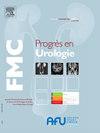Dépistage des patients à risque de cancer de la prostate avant chirurgie d’hypertrophie bénigne de la prostate
Q4 Medicine
引用次数: 0
Abstract
Introduction
L’hypertrophie bénigne de la prostate (HBP) et le cancer de la prostate (CaP) sont deux pathologies prévalentes chez le sujet âgé. Leur coexistence est fréquente, et bien qu’elles soient d’étiologies distinctes, elles partagent des facteurs de risque communs. Une situation clinique particulière se dégage : le dépistage d’un CaP lors de l’évaluation préopératoire d’une HBP.
Matériels et méthodes
Une revue de la littérature a été réalisée à partir de la base Medline pour identifier les articles pertinents sur le dépistage du CaP dans le cadre de l’HBP. Un total de 45 articles a été examiné.
Résultats
Le dosage du PSA, bien qu’utile, présente des limites dans le contexte de l’HBP. Des outils tels que la densité du PSA et l’IRM améliorent la détection du CaP avant la chirurgie d’HBP. Les biopsies prostatiques sont recommandées chez les patients présentant un PSA anormalement élevé, un toucher rectal suspect ou une IRM pathologique.
Conclusion
Un dépistage adéquat du CaP chez les patients atteints d’HBP avant chirurgie permet d’optimiser leur prise en charge. L’utilisation de biomarqueurs et d’outils d’imagerie est primordiale pour orienter le praticien. Quoi qu’il en soit, l’urologue doit adapter sa démarche diagnostique au contexte clinique général.
Introduction
Benign prostatic hyperplasia (BPH) and prostate cancer (PCa) are common conditions in older men. Their coexistence is frequent – even though they have distinct etiologies – as they share common risk factors. In this context, screening for PCa during the preoperative evaluation of BPH is of much interest.
Materials and methods
A literature review was conducted using the Medline database to identify relevant articles on PCa screening in the context of BPH. A total of 45 articles were examined.
Results
Risk factors such as age, family history, and ethnicity influence the coexistence of BPH and PCa. PSA testing, while useful, has limitations in the context of BPH. Tools like PSA density and MRI improve the detection of PCa before BPH surgery. Prostate biopsies are recommended for patients with elevated PSA, suspicious digital rectal exams or abnormal MRI.
Conclusion
Adequate PCa screening in patients with BPH before surgery optimizes management. The use of biomarkers and imaging tools can improve diagnostic accuracy. Anyhow, practitioners must adapt their diagnostic approach to the general clinical context.
良性前列腺肥大手术前前列腺癌高危患者筛查
良性前列腺肥大(BPH)和前列腺癌(CaP)是老年人的两种常见疾病。它们经常共存,虽然它们的病因不同,但它们有共同的风险因素。一种特殊的临床情况出现了:术前HBP评估中CaP的筛查。材料和方法在Medline数据库中进行了文献综述,以确定与HBP下CaP筛查相关的文章。共审查了45篇文章。结果PSA的剂量虽然有用,但在HBP的背景下存在局限性。PSA密度和MRI等工具可以在HBP手术前改善CaP的检测。对于PSA异常升高、疑似直肠接触或病理MRI的患者,建议进行前列腺活检。结论:术前对HBP患者进行适当的CaP筛查可优化其治疗。生物标志物和成像工具的使用对指导从业人员至关重要。在任何情况下,泌尿科医生都必须根据一般临床情况调整诊断方法。介绍良性前列腺增生(BPH)和前列腺癌(PCA)是老年男性的常见情况。它们经常共存——即使它们有不同的病因——因为它们有共同的风险因素。在这种情况下,在术前BPH评估期间对PCA进行筛查是非常有趣的。使用Medline数据库进行文献综述,以确定在BPH背景下关于PCA筛查的相关文章。共审查了45篇文章。风险因素,如年龄,家族史和种族影响BPH和PCa的共存。PSA测试虽然有用,但在BPH的背景下存在局限性。像PSA密度和MRI这样的工具可以在BPH手术前改善PCa的检测。前列腺活检建议用于PSA升高、可疑直肠数字检查或异常MRI的患者。结论:BPH患者术前适当的PCA筛查优化管理。生物标志物和成像工具的使用可以提高诊断的准确性。然而,从业人员必须使他们的诊断方法适应一般临床环境。
本文章由计算机程序翻译,如有差异,请以英文原文为准。
求助全文
约1分钟内获得全文
求助全文

 求助内容:
求助内容: 应助结果提醒方式:
应助结果提醒方式:


